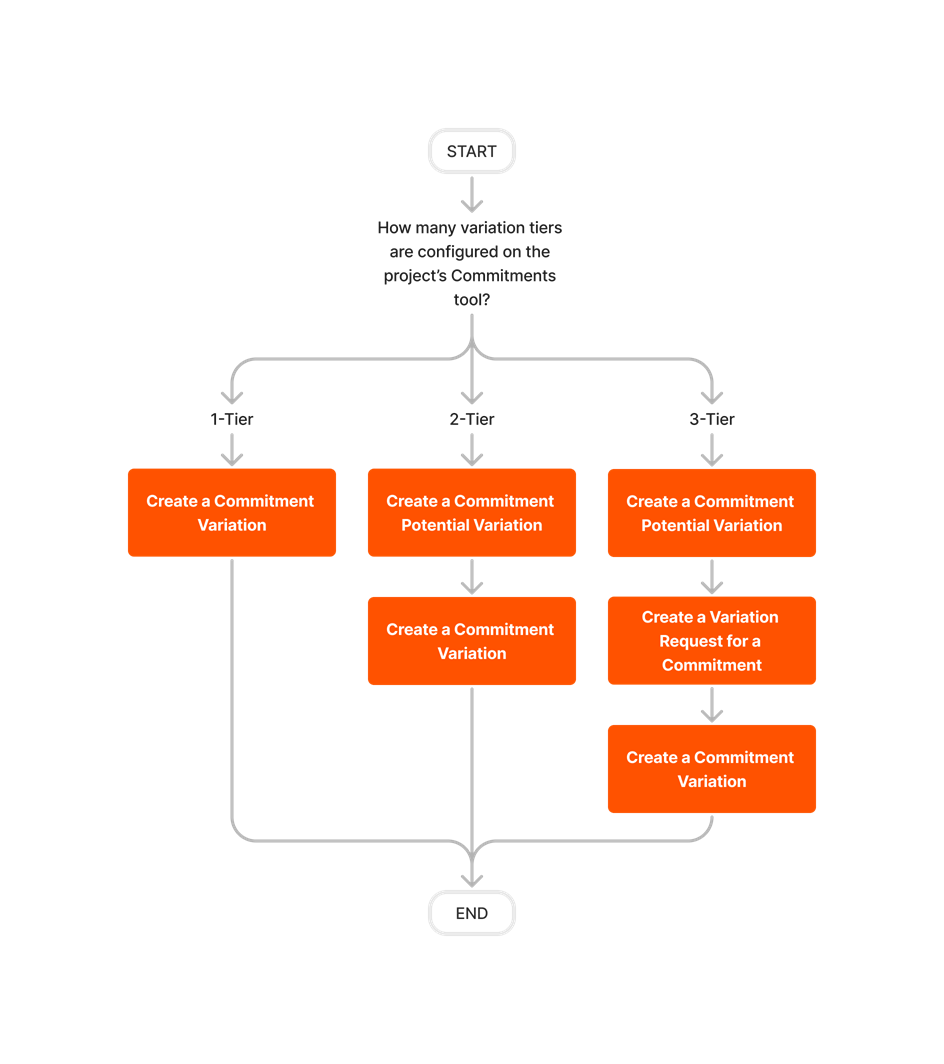What are the different variation tier settings in Project Financials?
Answer
In Procore Project Financials, the variation tier settings determine the number of steps that must be completed in your project team's workflow when creating variations for a client contract, commitment, funding, or head contract. In Procore Project Financials, your team can choose from a One (1)-tier, Two (2)-tier- or Three (3)-tier configuration setting.
Important
- Always configure the variation tier setting on a Project Financials tool before allowing your team to create variations.
- After you create one (1) or more variations on a Project Financials tool, you cannot change your setting.
To learn how variation tiers can be configured in these Project Financials tools, see a link below:
- Client Contract Variation Tiers
- Funding Variation Tiers
- Head Contract Variation Tiers
- Commitment Variation Tiers
Client Contract Variation Tiers
The Client Contracts tool can be set up to manage your project's variations using a 1-tier, 2-tier- or 3-tier configuration. See Configure the Number of Client Contract Variation Tiers. The following workflow diagram describes how your users will manage variations, depending upon the configuration setting you choose for the Client Contracts tool.
- One (1) Tier Variations
This configuration setting allows you to create a variation when there is a change to the original scope of work on a client contract. Client contract variations can then be sent to the head contractor or client for approval. - Two (2) Tier Variations
This is Procore's default configuration setting. It requires your project team to first create a potential variation. Potential variations can then be grouped into a client contract variation. Client contract variations can then be sent to the head contractor or client for approval.Note
If your billing process does NOT require you to group all of the approved variations for the month into a single, combined variation for final signature, the two-tier configuration is the recommended setting for the Client Contracts tool. - Three (3) Tier Variations
This is an uncommon configuration setting to implement in Procore. It requires your project team to first create a potential variation. Potential variations are then added individually or grouped into a variation request. Next, a variation request is submitted for approval. After approval, variation request can be grouped into a single client contract variation and sent to the head contractor or client for approval.
Funding Variation Tiers
The Funding tool can be set up to manage your project's variations using a 1-tier, 2-tier- or 3-tier configuration. See Configure the Number of Variation Tiers for the Funding Tool. The following workflow diagram describes how your users will manage variations, depending upon the configuration setting you choose for the Funding tool.
- One (1) Tier Variations
This configuration setting allows you to create a variation when there is a change to the original scope of work on a funding. Funding variations can then be sent to the funding source for approval. - Two (2) Tier Variations
This is Procore's default configuration setting. It requires your project team to first create a potential variation. Potential variations can then be grouped into a funding variation. Funding variations can then be sent to the funding source for approval.Note
If your billing process does NOT require you to group all of the approved variations for the month into a single, combined variation for final signature, the two-tier configuration is the recommended setting for the Funding tool. - Three (3) Tier Variations
This is an uncommon configuration setting to implement in Procore. It requires your project team to first create a potential variation. Potential variations are then added individually or grouped into a variation request. Next, a variation request is submitted for approval. After approval, variation requests can be grouped into a single funding variation and sent to the funding source for approval.
Head Contract Variation Tiers
The Head Contract tool can be set up to manage your project's variations using a 1-tier, 2-tier- or 3-tier configuration. See Configure the Number of Head Contract Variation Tiers. The following workflow diagram describes how your users will manage variations, depending upon the configuration setting you choose for the Head Contracts tool.
- One (1) Tier Variations
This configuration setting allows you to create a variation when there is a change to the original scope of work on a head contract. Head contract variations can then be sent to the project owner for approval. - Two (2) Tier Variations
This is Procore's default configuration setting. It requires your project team to first create a potential variation. Potential variations can then be grouped into a head contract variation. Head contract variations can then be sent to the project owner for approval.Note
If your billing process does NOT require you to group all of the approved variations for the month into a single, combined variation for final signature, the two-tier configuration is the recommended setting for the Funding tool. - Three (3) Tier Variations
This is an uncommon configuration setting to implement in Procore. It requires your project team to first create a potential variation. Potential variations are then added individually or grouped into a variation request. Next, a variation request is submitted for approval. After approval, variation requests can be grouped into a single head contract variation and sent to the project owner for approval.
Commitment Variation Tiers
The Commitments tool can be set up to manage your project's variations using a 1-tier, 2-tier-, or 3-tier configuration. See Configure the Number of Commitment Variation Tiers. The following workflow diagram describes how your users will manage variations, depending upon the configuration setting you choose for the Commitments tool.
- One (1) Tier Change Orders
This is Procore's default configuration setting. It allows you to create a change order when there is a change to the original scope of work on a commitment. Commitment change orders can then be sent to the downstream collaborator for approval. - Two (2) Tier Change Orders
This setting requires your project team to first create a commitment potential change order. Commitment potential change orders can then be grouped into a commitment change order. Commitment change orders can then be sent to the downstream collaborator for approval. - Three (3) Tier Variations
This is an uncommon configuration setting to implement in Procore. It requires your project team to first create a commitment potential variation. Commitment potential variations are then added individually or grouped into a variation request. Next, a variation request is submitted for approval. After approval, variation requests can be grouped into a single commitment contract variation and sent to the downstream collaborator for approval.In Beta
If you decide to use the two (2) or three (3) tier configuration setting, you also have the option of allowing your project collaborators to create their own Potential Variations (PVs). To learn more, see Allow Collaborators to Submit Site-initiated Variations (Beta).
See Also
- Configure the Number of Client Contract Variation Tiers
- Configure the Number of Commitment Variation Tiers
- Configure the Number of Funding Variation Tiers
- Configure the Number of Head Contract Variation Tiers
 The Client Contracts tool is available as a
The Client Contracts tool is available as a 
























